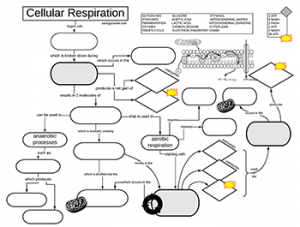
Students complete a graphic organizer that shows the process of cellular respiration. A word bank is provided to help them trace the flow of ATP and NADH in the process as well as identifying where each step occurs.
Cellular respiration is a series of chemical reactions that take place in the cells The process converts glucose into energy. All living things obtain energy from the food they eat.
Cellular respiration takes place in two stages: glycolysis and the Krebs cycle. Glycolysis is the first stage of cellular respiration. It takes place in the cytoplasm of the cell. In glycolysis, glucose is broken down into pyruvate and two molecules of ATP.
The Krebs cycle is the second stage of cellular respiration and it takes place in the mitochondria of the cell. Pyruvate is broken down into carbon dioxide and energy is released. The energy is used to create ATP.
Cellular respiration is a very important process because it provides energy for all living things. It is also a very efficient process, as it can produce a lot of ATP from a small amount of glucose.
The Graphic Organizer
This graphic organizer starts with glycolysis and includes mention of anaerobic processes (fermentation), then shows how NADH and ATP moves into the Kreb’s cycle. In this cycle, the majority of ATP produced in respiration comes from the electron transport chain.
The overall reaction is
C6H12O6 + 6O2 → 6CO2 + 6H2O + ATP
I’ve used this worksheet in my class and students provided feedback that it really helped them get the “big picture.” Lecture notes often break the process down into the three steps, focusing on the outputs of each step.
I have google slides that I use with my AP Bio class and students watch and offer them several videos to view, including “Cellular Respiration” by the Amoeba Sisters.
This graphic is usually given after these learning activities as a way to pull all of the information back together into one big picture.

